Lumos Board Game - Blueprint
Designed for INST728 by Ameya Patil and Yi Cai
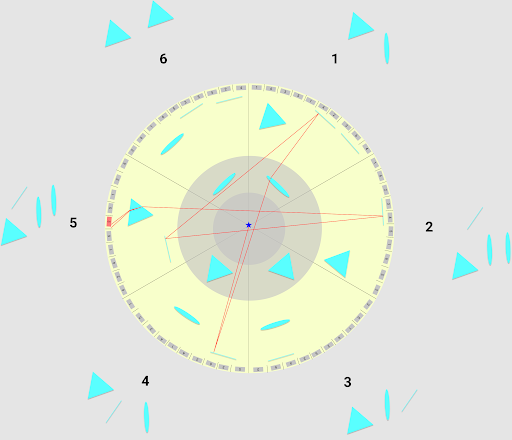
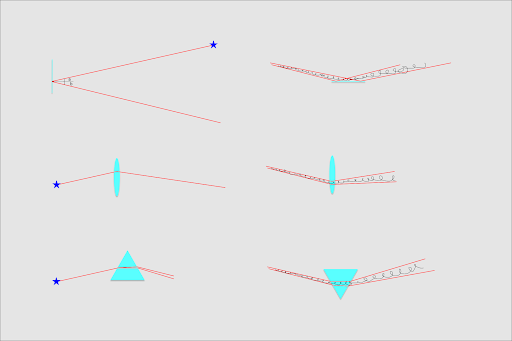
Gameboard & Pieces
Lumos contains a circular board with the circumference divided into 60 arcs. The area of the circular board is divided into as many sectors as there are players. A sector defines the playing area for each player. The 60 arcs are equally and randomly assigned to the players. The board has a light source at the centre which emits light in one single radial direction randomly chosen at each turn. Each player is also given a fixed set of mirrors, lenses and prisms, called ‘pieces’ hereon. For example, as show in Fig. 1, for 6 players, there will be 6 sectors, one for each player. Each sector and thus each player will have 12 arcs assigned which can be anywhere along the circumference.
Rules & Mechanics
The game is played in turns. At each turn, the board is hidden and all you can see is your assigned sector. All the players arrange their pieces in their allotted playing sector. Once everyone is done arranging their pieces, the board is revealed to everyone. The light source is triggered. It emits light in a randomly chosen radial direction, interacts with the pieces placed by the players in their respective sectors, and eventually hits the circumference of the board along one or more arcs. At the start of the game, all the arcs are in a 'reset' state. On being hit by the light beam, the arcs which are in the 'reset' change to the 'set' state and the game proceeds to the next round. The objective of the game is to light up all your assigned arcs before everyone else within 20 turns. If the game reaches 20 turns and no one has 'set' all of their arcs, the person with the most number of arcs 'set', wins the game
No player is allowed to see how the other players have arranged their pieces. No changes in the piece arrangement can be made after the board is revealed to everyone. If the light hits an arc directly, i.e. without interacting with any of the pieces, that hit does not count if that arc was in a ‘reset’ state, and it gets ‘reset’ if it was in a ‘set’ state. A light beam which has interacted with at least 1 piece hits an arc in the 'set' state, it has no effect on the state of that arc. To prevent any player from gaining unfair advantages of interacting with the light the most, circular tracks are marked on the board which restrict the number of pieces that can be placed in them. Specifically, the darker grey area in the center prohibits any placement of pieces, and the light grey area around the center can only have one piece placed in it for each player.
Genre, Premise & Story
Lumos is a strategic board game that has elements of randomness implemented in the game. The premise of the game is set in a wizarding world where all the players are prisoners trapped in a magic castle by a dark wizard. Each cel has multiple locks (equal to the number of arcs assigned to each player). The lock of each prison cell can be opened from a hidden inaccessible circular room (the board game) by deflecting a certain light that flashes once in a while, onto certain bricks in the wall. Each of these bricks correspond to one lock of your prison cell. You, being a wizard, can place objects that interact with the light, in that room, using magic. However the light in that room is very bright/harsh so it will not affect the locks if it falls on the brick directly. To successfully open the locks to your cell, you need to light up all your bricks only with deflected light which reduces the light intensity. You need to make sure that you do so before the others because the opening of one prison cell will alert the guards and the rest will not be able to get out of the prison in time. There is only enough time for one wizard to escape the prison.
Challenges & Nuances
The challenge in the game is to understand how light would interact with the pieces arranged by the players, as shown in Fig. 2 and making sure it hits the desired arcs while avoiding other arcs. Since the light is emitted in a randomly chosen direction, there is unpredictability in terms of how things would turn out after each turn. All that can be done is to arrange the pieces such that the chances of hitting the desired arcs are maximised. Since the arcs allotted to the players need not be adjacent to each other, and in fact different players may have their arcs adjacent to each other, this encourages players to try and create alliances to improve the chances of light hitting their arcs. Further, once an arc is ‘set’, it becomes the responsibility of the owner of that arc to protect it from getting hit directly by the light beam. However, the arcs of one player (A) can lie in the sector of another player (B), this further calls for more forced alliances to be created and previous alliances to be broken.
Lumos Video Game - Blueprint
Designed for INST728 by Ameya Patil and Yi Cai
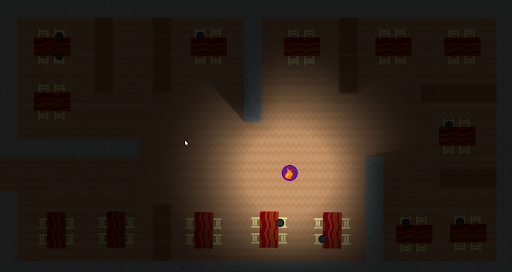
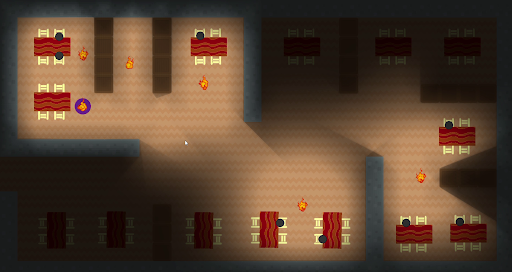
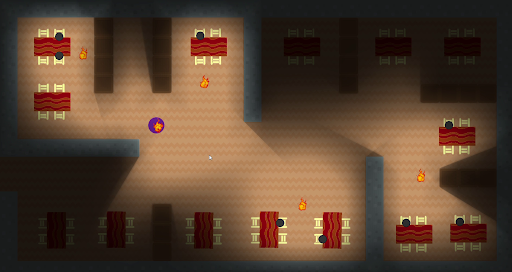
Game Premise
You are a librarian in the Hogwarts school of Witchcraft and Wizardry. Since it's the Harry Potter universe, there is no electricity. It’s a huge stone castle with dark and dingy corridors. You are about to start your ritual of setting up fire torches for the students to study. However, you don’t want to set up one too many torches, and neither do you want to deprive any student of the right to study in the school library. The aim is to light up the place by using a minimum number of torches and placing them optimally in all the rooms on each floor of the library.
Game Mechanics
Each room in the library represents one level of the game. Each such level would have a different layout of tables, chairs, students, walls and bookshelves. Some of the rooms would also have a window which means natural light during daytime. A torch need not be placed near windows. The time of day would also be changed on different levels to increase the permutations for designing a level.
The player (librarian) enters the room (level) with a lit torch and moves around the room using arrow keys. The torch can be placed at a desired location by pressing the Spacebar. The Spacebar places a torch at the location and also lights up another one which the player can move around with to check how it looks, before placing it anywhere. The librarian cannot walk through walls and bookshelves.
The player can remove a torch placed at any position by left mouse clicking on the torch sprite.
Each student object in the library would keep track of all the torches placed in the room, and the total light received from these torches. If this total light was above a threshold, the student sprite would indicate this.
Each level would have an optimal number of torches to be used. The player would be scored for a level, based on how many torches the player uses, more or less than the optimal number. If the player uses more than the optimal number of torches, less points would be awarded, compared to when the player uses less than the optimal number of torches.
To add to the challenge in the game, the librarian can also ask any student to rearrange or move to a different table, if it helps to reduce the number of torches. The student can either choose to comply or not do so. The student would be governed by the game AI, but it would be deterministically set for each student in each room (level).
No player is allowed to see how the other players have arranged their pieces. No changes in the piece arrangement can be made after the board is revealed to everyone. If the light hits an arc directly, i.e. without interacting with any of the pieces, that hit does not count if that arc was in a ‘reset’ state, and it gets ‘reset’ if it was in a ‘set’ state. To prevent any player from gaining unfair advantages of interacting with the light the most, circular tracks are marked on the board which restrict the number of pieces that can be placed in them. Specifically, the darker grey area in the center prohibits any placement of pieces, and the light grey area around the center can only have one piece placed in it for each player.